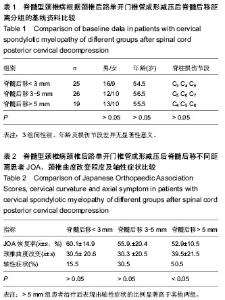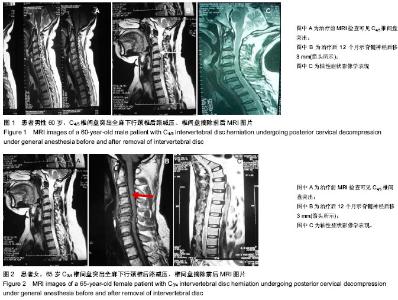Chinese Journal of Tissue Engineering Research ›› 2014, Vol. 18 ›› Issue (13): 2037-2042.doi: 10.3969/j.issn.2095-4344.2014.13.012
Previous Articles Next Articles
Correlation of posterior cervical decompression with spinal cord shifting backward distance and axial symptoms
Wang Hao1, 2, Wang Pei3
- 1Tianjin Medical University, Tianjin 300070, China; 2Affiliated Hospital of the Chinese People’s Armed Police Force Logistics College, Tianjin 300162, China; 3General Hospital of Tianjin Medical University, Tianjin 300052, China
-
Received:2014-01-04Online:2014-03-26Published:2014-03-26 -
Contact:Wang Pei, Chief physician, Doctoral supervisor, General Hospital of Tianjin Medical University, Tianjin 300052, China -
About author:Wang Hao, Studying for doctorate, Attending physician, Tianjin Medical University, Tianjin 300070, China; Affiliated Hospital of the Chinese People’s Armed Police Force Logistics College, Tianjin 300162, China
CLC Number:
Cite this article
Wang Hao, Wang Pei. Correlation of posterior cervical decompression with spinal cord shifting backward distance and axial symptoms [J]. Chinese Journal of Tissue Engineering Research, 2014, 18(13): 2037-2042.
share this article
| [1] 黄玉国,申勇,丁文元,等.前后路手术治疗脊髓型颈椎病伴椎管狭窄[J].中国矫形外科杂志, 2009,17(19):1508-1509.[2] 韩国伟,刘少喻,梁春祥,等.羟基磷灰石人工骨在颈椎后路双开门椎管扩大成形治疗中的应用[J].中国组织工程研究与临床康复, 2009,13(29):5661-5664.[3] 申勇,任虎,张英泽,等.肌电图联合MRI判断脊髓型颈椎病预后的相关性分析[J].中国矫形外科杂志, 2010, 18(1): 42-45.[4] 丁慧新,王自立,庞龙,等.单开门椎管扩大成形术治疗无骨折脱位型颈脊髓损伤[J].中国脊柱脊髓杂志, 2002, 12(6): 369-370.[5] Hironobu S,Nobru N,Yoshihiro M,et al.Long-term outcome of laminoplasty for cervical myelopathy due to disc herniation a comparative study of laminoplasty and anterior spinal fusion. Spine.2005;7:756-759.[6] Yukawa Y,Kato F,Yoshihara H,et al.MR T2 image classification in cervical compression myelopathy:predictor of surgical outcomes. Spine.2007;32(15):1675-1678.[7] Uchida K, Nakajima H, Yayama T , et al.Anterior and posterior decompressive surgery for progressive amyotrophy associated with cervical spondylosis:a retrospec-tive study of 51 patients.J Neurosurg Spine.2009;11(3):330-337.[8] Kawaguchi Y,Kanamori M, Ishihara H,et al.Minimum 10- year followup after en bloc cervical laminoplasty.Clin Orthop.2003; 411: 129-139.[9] 张为,陈百成,申勇,等.颈3椎板切除单开门成形术对颈椎轴性症状的影响[J].中华骨科杂志, 2006, 26(8): 544-5481[10] Kulkalni V,Rajshekhar V,Raghuram L.Accelerated spondylotic chan-ges adjacent to the fused segment following central cervical corpecto-my: magnetic resonance imaging study evidence.Neurosurg.2004;100:2-6.[11] Kawakami M, Tamaki T, Yamada H. Relationships between sagittal alignment of the cervical spine and morphology of the spinal cord and clinical outcomes in the patients with cervical spondylotic myelopathy treated with expansive laminoplasty.Spinal Disord Tech.2002;15:391-397.[12] Lee J, Sharan A, Baron E. Quantitative prediction of spinal cord drift after cervical laminectomy and arthrodesis. Spine. 2006;31:1795-1798.[13] IizukaH, Shimizu T, Tateno K,et al. Extensormusculature of the cervical spine after laminoplasty: morphologic evaluation by coronal view of the magnetic resonance image. Spine. 2001;26(20): 2220-2226.[14] 张为,董玉昌,中勇,等.保留颈半棘肌肌止的椎板成形术的临床应用[J]. 中国矫形外科杂志, 2006, 14(13): 980-982.[15] Hosono N,Sakaura H,Mukai Y,et al.C3-6 laminoplasty takes over C3-7 laminoplasty with significantly lowerincidence of axial neckpain. EurSpine.2006;15(9): 1375-1379.[16] Holly LT, Moftakhar P, Khoo LT, et al. Sursical outeomes of elderly patients with cervieal spondylotic myelopathy. Surg Neurol.2008;69(3):233-240.[17] Suri A,Chabbra RP,Mehta VS,et al.Effeet of intramedullary signal changes on the surgieal outeome of patients with cervieal spondylotic myelopathy.Spine. 2003;3(l):33-45.[18] Chagas H, Domingnes F, Aversa A,et al.Cervical spondylotic myelopathy: 10 years of prospective outcome analysis of anterior decompression and fusion. Surg Neurol.2005; 64: 30-35.[19] Houten JK, Cooper PR. Laminectomy and posterior cervical plating formultilevel cervical spondylotic myelopathy and ossification of the posterior longitudinal ligament:effects on cervical alignment,spinal cord compression,and neurological outcome.Neurosurgery.2003;52(5):1081-1087.[20] Seichi A,Takeshita K,Kawaguchi H,et al.Postoperative expansion of intramed-ullary high-intensity areas on T2-weighted magnetic resonance imaging after cervical laminoplasty. Spine.2004;29(13):1478-1482.[21] Bommireddy R, Kamat A, Smith ET, et al.Magnetic resonance image findings in the early post-operative period after anterior cervical discectomy. Eur Spine J. 2007;16(1)27-31.[22] 朱庆三,刘景臣,李英普,等.不同来源植骨块在中老年人颈椎后路双开门椎管扩大成形术中的应用[J].中国老年学杂志,2003, 8(23):522-524.[23] Iwasaki M, Okuda S, Miyauchi A, et al. Surgical strategy forcervicalmyelopathy due to ossification of the posterior lon gitudinal ligament: part2: advantages of anterior decompression and fusion over laminoplasty.Spine (Phila Pa 1976) 2007;32(6):654-660.[24] Edwards CC 2nd,Heller JG,Murakami H.Corpectomy versus laminoplasty for multilevel cervical myelopathy: an indep endent matched cohort analysis. Spine 2002;27(11): 1168-1175.[25] Yonenobu K, Hosono N, Iwasaki M, et al. Lami noplasty versus subtotalcorpectomy. A comparative study of results in multisegmental cervical spondylotic myelopathy. Spine ( Phila Pa 1976).1992; 17(11):1281-1284.[26] Sodeyama T, Goto S, Mochizuki M, et al. Effect of decompression enlargement laminoplasty for posterior shifting of the spinal cord. Spinea) (Phila Pa 1976) 1999;24(15):1527-1531 [discussion: 1531-2][27] Epstein NE. Laminectomy for cervical myelopathy. Spinal Cord.2003;41: 317-327.[28] Kaptain GJ, Simmons NE, Replogle RE, et al. Incidence and outcome of kyphotic deformity following laminectomy for cervical spondylotic myelopathy.J Neurosurg.2000;93: 199-204.[29] Wiggins GC,Shaffrey CI.Dorsal surgery for myelopathy and myeloradicuiopathy.Neurosurgery.2007; 60S: 71- 81.[30] Henderson FC, Geddes JF,Vacarro AR et al Stretch—associated injury in cervical spondylotic myelopathy:new concept and review.Neurosurgery. 2005;56(5):1101-1113; discussion 1101-1113.[31] Baptiste DC, Fehlings MG. Pathophysiology of cervical myelopathy.Spine J.2006; 6:190S-197S.[32] Law MD, Bernhardt M,White AA, et al. Evaluation and Management of Cervical Spondylotic Myelopathy. J Bone Joint Surg Am.1994;76(22):1420-1423.[33] Hirabayashi K, Watanabe K, Wakano K,et al Expansive open door lamin oplasty for cervical smotic myelopathy. Spine. 1983;8(6): 693-699.[34] 贾连顺,徐印坎.手术治疗脊髓型颈椎病的长期疗效评价[J].中国矫形外科杂志, 2001, 8(8):735-737.[35] 侯永洋,施伟,辛兵,等.不同外科术式治疗多节段脊髓型颈椎病的疗效评价[J].徐州医学院学报, 2006, 26(2):161-164.[36] Kawakam M, Tamaki T, Iwasaki H,et al. Acomparative study of surgical approaches for cervical compressive myelopathy. Clin Orthop Relat Res.2000;1: 129-136.[37] Edwards CC,Heller JG,Murakcami H. Corpectomy versus laminoplasty formultilevel cervicalmyelopathy: an independentmatched cohortanalysis.Spine.2002;11: 1168-1175.[38] Baron EM, Young WF. Cervical spondylotic myelopathy: a brief review of its pathophysiology,clinicical course, and diagnosis.Neurosurgery.2007; 60S: 35-41.[39] 马如龙,张华,李世和,等.脊髓型颈椎病手术治疗有关问题探讨[J].中国脊柱脊杂志,1998, 2(8):97-98.[40] Swank ML,Sutterlin CE ,Bossons CR et al.Rigid interal fixation with lateral mass plates in Multilevel anterior and posterior reconstruction of the cervical spina. Spina.1997; 22(3):274-282.[41] Schultz KD Jr, Mclauqhlin MR, Haid RW, et al.Single-state anterior-posterior decompression and stabilization for com plex cervical spine disorders. Neurosurd.2000; 93(2Suppl): 214-221.[42] Huang XW, Liu XY,Xiao S,et al. Posterior extended laminoplasty for the treatment cervical Spondylotic myelop athyl.China Journal of Medical Medicine.2004; 14(8):134-136.[43] 李康华,肖晟,胡建中.一期前后路颈椎减压治疗钳夹型脊髓型颈椎病[J].中国医学工程,2006, 14(4):55-57.[44] Guigui P,Lefevre C, assale B, et al.Static,dynamic changes of the cervical spine after Lamineetomy for cervical sp ndylotic myelopathy. Rev Chir Orthop Reparatriee Appar Mot. 1998; 84(1):17-25.[45] Mefty O, Harkey HL, Marawi I,et al.Experimental chronic compressive cervical myelopathy. J Neurosurg. 1993; 79(4): 550-561.[46] Bernhardt M,Hynes RA,Blume HW,et al.Current Concept review: cervical spondyrlotic myelopathy. J Bo ne Joint Surg(Am).1993;75(1):119 -128.[47] Heller JG,Silox H,Sutterlin CE.Complication of posterior cervical plating.Spine.1995;20:2442-2448.[48] 王开明,脊髓型颈椎病的于术治疗及进展[J].淮海医药, 2007, 25(2):188-199.[49] 黄必留,李书刚,张普国,等.颈椎棘突纵切双开门扩大植骨成形术后椎管面积与神经功能改善的2年随访[J].中国临床康复,2004, 8(5):824-825.[50] Otani K, Sato K, Yabuki S, et al. A segmental partial laminecto my for cervical spondylotic myelopathy:anantomi cal basis and clinical outcome in comparison with expansive open-door laminoplasty. Spine.2009;34:268-273. |
| [1] | Min Youjiang, Yao Haihua, Sun Jie, Zhou Xuan, Yu Hang, Sun Qianpu, Hong Ensi. Effect of “three-tong acupuncture” on brain function of patients with spinal cord injury based on magnetic resonance technology [J]. Chinese Journal of Tissue Engineering Research, 2021, 25(在线): 1-8. |
| [2] | Jiang Hongying, Zhu Liang, Yu Xi, Huang Jing, Xiang Xiaona, Lan Zhengyan, He Hongchen. Effect of platelet-rich plasma on pressure ulcers after spinal cord injury [J]. Chinese Journal of Tissue Engineering Research, 2021, 25(8): 1149-1153. |
| [3] | Chai Le, Lü Jianlan, Hu Jintao, Hu Huahui, Xu Qingjun, Yu Jinwei, Quan Renfu. Signal pathway variation after induction of inflammatory response in rats with acute spinal cord injury [J]. Chinese Journal of Tissue Engineering Research, 2021, 25(8): 1218-1223. |
| [4] | Wan Ran, Shi Xu, Liu Jingsong, Wang Yansong. Research progress in the treatment of spinal cord injury with mesenchymal stem cell secretome [J]. Chinese Journal of Tissue Engineering Research, 2021, 25(7): 1088-1095. |
| [5] | Kong Desheng, He Jingjing, Feng Baofeng, Guo Ruiyun, Asiamah Ernest Amponsah, Lü Fei, Zhang Shuhan, Zhang Xiaolin, Ma Jun, Cui Huixian. Efficacy of mesenchymal stem cells in the spinal cord injury of large animal models: a meta-analysis [J]. Chinese Journal of Tissue Engineering Research, 2021, 25(7): 1142-1148. |
| [6] | Xie Yang, Zhang Shujiang, Liu Menglan, Luo Ying, Yang Yang, Li Zuoxiao. Mechanism by which rapamycin protects spinal cord neurons in experimental autoimmune encephalomyelitis mice [J]. Chinese Journal of Tissue Engineering Research, 2021, 25(5): 695-700. |
| [7] | Ma Binxiang, He Wanqing, Zhou Guangchao, Guan Yonglin. Triptolide improves motor dysfunction in rats following spinal cord injury [J]. Chinese Journal of Tissue Engineering Research, 2021, 25(5): 701-706. |
| [8] | Luo Xuanxiang, Jing Li, Pan Bin, Feng Hu. Effect of mecobalamine combined with mouse nerve growth factor on nerve function recovery after cervical spondylotic myelopathy surgery [J]. Chinese Journal of Tissue Engineering Research, 2021, 25(5): 719-722. |
| [9] | Sun Jianwei, Yang Xinming, Zhang Ying. Effect of montelukast combined with bone marrow mesenchymal stem cell transplantation on spinal cord injury in rat models [J]. Chinese Journal of Tissue Engineering Research, 2021, 25(25): 3962-3969. |
| [10] | Xu Weilong, Zuo Yuan, Xin Daqi, He Chenyang, Zhao Peng, Shi Ming, Zhou Boyuan, Liu Yating, Zhao Yan. Selection of modeling methods for acute compressive spinal cord injury: a network Meta-analysis [J]. Chinese Journal of Tissue Engineering Research, 2021, 25(23): 3767-3772. |
| [11] | Fan Junchao, Chen Yong, Song Junjie. Sevoflurance combined with xenon pretreatment protects against spinal cord ischemia-reperfusion injury in a rat model [J]. Chinese Journal of Tissue Engineering Research, 2021, 25(23): 3660-3665. |
| [12] | Yan Peng, Ma Yufei, Cui Jingfu, Hao Shaofei, Liu Jinhui, Guan Chunlei, Wang Xiaoran, Yang Xiaoyu. Mechanism of anodic block electrical stimulation of sacral nerve root to reconstruct bladder function [J]. Chinese Journal of Tissue Engineering Research, 2021, 25(23): 3684-3689. |
| [13] | Tian Ting, Li Xiaoguang. Problems and challenges in regeneration and repair of spinal cord injury [J]. Chinese Journal of Tissue Engineering Research, 2021, 25(19): 3039-3048. |
| [14] | Xia Guoming, Xu Qiang, Liu Xuqiang, Yu Xiaolong, Dai Min. Application and effect of induced pluripotent stem cells in bone surgery tissue engineering [J]. Chinese Journal of Tissue Engineering Research, 2021, 25(19): 3077-3082. |
| [15] | Ren Bingkai, Zheng Yibin, Huang Leiwen, Wu Fanhui, Yang Dong . Value of respiratory tract management and fiberoptic bronchoscopy in traumatic cervical spinal cord injury [J]. Chinese Journal of Tissue Engineering Research, 2021, 25(18): 2902-2907. |
| Viewed | ||||||
|
Full text |
|
|||||
|
Abstract |
|
|||||





